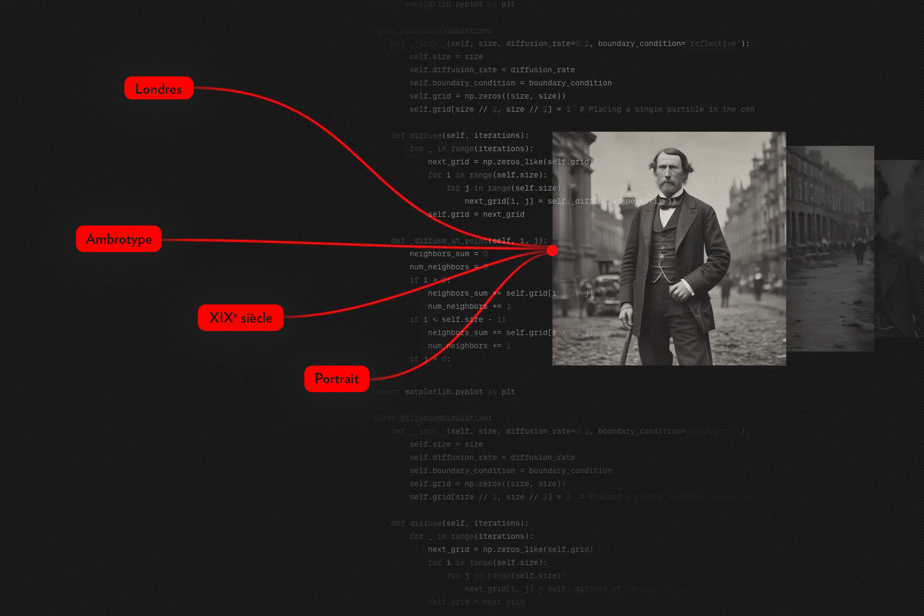Photographer Marc Montplaisir has been passionate about ambrotypes for years, photos produced with a complex photographic process dating from the 19th century.e century which he sometimes uses to make singular portraits of well-known personalities.
It was therefore with enthusiasm that he discovered at the end of 2022 a series of alleged portraits of Londoners who had escaped his attention.
“I was confused for 10 minutes before realizing that it was done with Midjourney,” underlines the professional, referring to a popular artificial intelligence program that allows you to generate photos from written instructions.

IMAGE GENERATED BY ARTIFICIAL INTELLIGENCE
This image, generated by artificial intelligence, is part of a series of alleged portraits of Londoners released in 2022.
“I was half amazed, half terrified,” notes Mr. Montplaisir, who himself subsequently experimented with the program to make his own “artificial” ambrotypes.
In particular, he produced a series of portraits showing dancers from the Paris opera on the occasion of the inauguration of the Eiffel Tower which speak volumes of truth.
Mr. Montplaisir, who does advertising photography, also practiced generating polished images using artificial intelligence, notably a flamboyant young couple of travelers emerging from a plane.
-

IMAGE GENERATED BY ARTIFICIAL INTELLIGENCE
Using the artificial intelligence program Midjourney, Marc Montplaisir produced portraits showing dancers from the Paris Opera during the inauguration of the Eiffel Tower.
-

IMAGE GENERATED BY ARTIFICIAL INTELLIGENCE
Using the artificial intelligence program Midjourney, Marc Montplaisir produced portraits showing dancers from the Paris Opera during the inauguration of the Eiffel Tower.
-

IMAGE GENERATED BY ARTIFICIAL INTELLIGENCE
It also generated, again with artificial intelligence, a polished image of a couple of travelers emerging from a plane.
1/3
Results again comparable to those he could obtain by carrying out a real photography session, much more expensive, with models and the required support staff.
Advertising agencies are divided on the advisability of using the technology, says Mr. Montplaisir, who finds it “very anxiety-inducing” to see that artificial intelligence could deprive him of part of his livelihood.

PHOTO MARTIN CHAMBERLAND, THE PRESS
Marc Montplaisir, photographer
This is all getting very confusing.
Marc Montplaisir, photographer
The neophyte will have even more difficulty seeing clearly in the predicted deluge of images of all kinds, which risks having significant consequences on the way in which people obtain information and construct their vision of the world.
Serge Cabana, lecturer in communications at the University of Sherbrooke, notes that “in the future no one will be able to look at a photo without wondering if it is real or fabricated.”
The same dynamic is also likely to apply to audio recordings and even videos as the technology becomes more refined, a process that is already well advanced.

PHOTO PROVIDED BY SERGE CABANA
Serge Cabana, lecturer in communications attached to the University of Sherbrooke
It is an important collective landmark that is being lost. And when we lose our collective bearings, we also lose our ability to talk to each other.
Serge Cabana, lecturer in communications attached to the University of Sherbrooke
Mr. Cabana explores the problem more broadly in a book published in 2022 entitled Who will tell me the truth?.
A long erosion
Questions relating to “post-truth” or “the erosion of truth” – a term put forward in particular by the RAND Corporation in a long study published in 2018 – are not new.
The organization was then alarmed by a shift in political and civic discourse favoring “personal opinion and attitudes” rather than the analysis of “facts and data”.
In a work published in 2019 entitled The Death of Truth (The death of truth)the author Michiko Kakutani, former literary critic of New York Timesrelated in this vein comments from former Speaker of the House of Representatives Newt Gingrich, who contested the idea that crime was declining in the country despite clear statistics on this subject.
“As a political candidate, I prefer to base myself on what people feel and I will let you deal with the theoreticians,” declared the Republican politician to underline his contempt for numbers.
Mme Kakutani identified in his work postmodernism as one of the important original causes of this evolution.
By asserting that knowledge was “filtered through the prism of class, race, gender, and other variables,” proponents of this approach rejected the possibility of an objective reality by substituting the idea of subjectivity.
“Postmodernity took 50 years to penetrate the collective consciousness,” notes Serge Cabana, who sees its effect in the loss of authority of traditionally central institutions such as the media and universities.
“Today, everyone has the right to their opinion. The opinion of a person in the street who talks about cosmology is almost as important as that of Hubert Reeves,” he quips.
Social networks, which facilitate the dissemination of information or opinions by anyone with access to the Internet, have played an “accelerating” role in the process.
Platforms like Facebook,
The production of traditional media, weakened by changes in the advertising market, is struggling to reach a significant fraction of Internet users who claim to find their information online on sites of uncertain origin.
Scientists are not immune to this crisis of confidence either.
Criticism of public health researchers during the COVID-19 pandemic for their changing recommendations shows that many people do not understand how scientific knowledge is established and advances, notes Lilian Negura, professor in the Faculty of Social Sciences from the University of Ottawa.
“Science is not a religion,” notes the researcher, who is alarmed to note that people are less and less socially placed in the face of different opinions.
